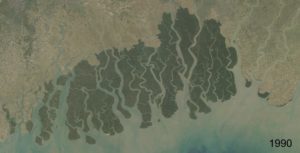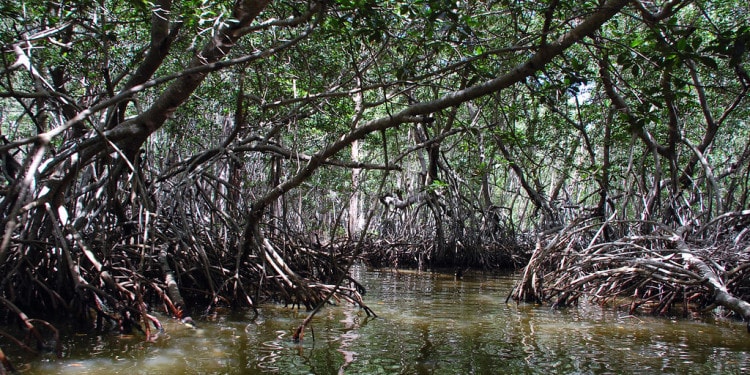Mangrove forests play an essential role in preserving the environment, fighting climate change, protecting shorelines and water quality. Now the world’s largest mangrove, the Sundarbans, is at risk.
 This article is part of an editorial collaboration with Earth.Org. The Earth.Org Series can be found here. The original publication can be found here.
This article is part of an editorial collaboration with Earth.Org. The Earth.Org Series can be found here. The original publication can be found here.
Now, a new coal power plant might wreak havoc on the already vulnerable Sunderbans.
The Sundarbans — the largest continuous mangrove forest on the planet that spans more than 10,000 sq km along the Bay of Bengal — is shrinking. Thanks to human encroachment and climate change, the forest has been losing almost 16 sq km of vegetation per year since 1991. Earth.Org’s own analysis based on satellite imagery, shows that in Bangladesh, home to the largest swath of Sundarbans mangroves, the forest has lost 442 sq km of its vegetation in the last 28 years. 71% of the forested coastline is also retreating by as much as 200 metres a year due to coastline erosion.
Containing multiple UNESCO Natural World Heritage sites within itself, the Sundarbans forest is home to a wide variety of plant and animal species. The flora is comprised of a rich mosaic of different types of vegetation; half of all known 110 mangrove species are found within the delta. It is home to over 260 bird species, Indian otters, spotted deer, wild boar, fiddler crabs, mud crabs, three marine lizard species and five marine turtle species dwell in this impervious maze. The forest also hosts endangered species like the estuarine crocodile, Indian python and the iconic Bengal tiger. The mangrove ecosystem plays an indispensable role as breeding and nursery ground coastal fisheries in the Bay of Bengal.
The Sundarban is also a natural barrier that protects over 6.5 million people who live in the region from tides and cyclones. For the inhabitants of surrounding areas, the forest is an abundant source of subsistence.
Human interference in the form of up-stream agriculture, industrial shrimp farming, logging, and hydrologic interventions have been gradually deteriorating the mangrove ecosystem.
Active human encroachment is coupled with the collateral effects of the climate crisis. The forested coastline is being rapidly overtaken by rising sea levels and storm surges. The increased salinity of the soil has made hectares of mangroves weaker and more vulnerable to retrenchment. Scientists warn that a continuing coastline retreat will trigger major mangrove disappearance within the next 50 years.

Earth.Org used NASA’s Landsat satellite data to generate images to analyse the changes in vegetation in Sunderbans.
—
A new threat
Construction of a new cross-border coal-fired power plant is underway in the nearby town of Rampal. Despite strong opposition from UNESCO, the 1320-megawatt plant is set to start generating power by March 2021.
Leading conservationists argue the power plant would spew thousands of tons of toxic coal ash, and air pollutants, discharge mercury-laden water at varying temperature into rivers, damaging water quality.
“Despite objections from UNESCO’s World Heritage Committee (WHC) and the International Union for the Conservation of Nature (IUCN), Bangladesh has approved more than 320 industrial projects in the area, including the massive Rampal coal-fired power plant, bypassing requirements for public participation and environmental impact assessment,” says United Nations (UN) expert John H. Knox
The bilateral cooperation between Bangladesh and India and the Ramsar Convention had improved conservation strategies at Sunderbans in the last decade. But experts say it is highly critical to avoid human pressure on the wetland and its resources in the future too. Both governments need to take environmental concerns into account while installing industrial projects near the mangrove forest.













